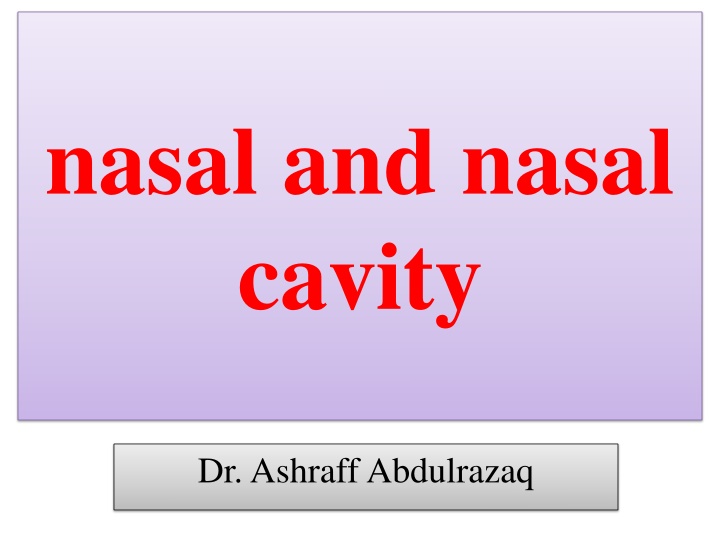
Nasal Cavity and Rhinotomy Procedures
Explore the anatomy of the nasal cavity, nasal septum, and paranasal sinuses. Learn about rhinotomy approaches for nasal cavity surgery, including dorsal, ventral, and lateral techniques. Discover how to perform a dorsal rhinotomy, elevate periosteum, and conduct nasal cavity exploration. Detailed images and step-by-step instructions provided.
Download Presentation

Please find below an Image/Link to download the presentation.
The content on the website is provided AS IS for your information and personal use only. It may not be sold, licensed, or shared on other websites without obtaining consent from the author. If you encounter any issues during the download, it is possible that the publisher has removed the file from their server.
You are allowed to download the files provided on this website for personal or commercial use, subject to the condition that they are used lawfully. All files are the property of their respective owners.
The content on the website is provided AS IS for your information and personal use only. It may not be sold, licensed, or shared on other websites without obtaining consent from the author.
E N D
Presentation Transcript
nasal and nasal cavity Dr. AshraffAbdulrazaq
Nasal cavity The nasal cavity extends from the nostrils to the nasopharyngeal meatus and is separated into two halves by the nasal septum . The septum is mostly cartilaginous but also has bony and membranous portions. The nasal conchae develop from the lateral and dorsal walls of the nasal cavity. The air passages between the conchae are known as the meatus. The paranasal sinuses include a maxillary recess, a frontal sinus, and a sphenoidal sinus. The frontal sinus occupies the supraorbital process of the frontal bone The two sides are separated by a median septum, and in dogs each side is divided into rostral, medial, and lateral compartments.
Rhinotomy - The nasal cavity may be approached through dorsal, ventral, or lateral approaches. - The dorsal approach is most commonly used for exploration and biopsy; however, the ventral approach can be used to explore the region caudal to the ethmoid turbinates and the ventral aspect of the turbinates. Lateral approaches are limited to lesions in the rostral aspect of the nasal cavity.
Rhinotomy Dorsal approach - to the nasal cavity and paranasal sinuses. - With the animal in ventral recumbency, make a dorsal midline skin incision from the caudal aspect of the nasal planum to the medial canthus of the orbit. Either or both sides of the nasal cavity can be entered through a single midline skin incision. - To explore the frontal sinus, extend the incision caudal to a line that connects the zygomatic processes of the frontal bone. Incise the subcutaneous tissue and periosteum on the midline.
Rhinotomy Elevate the periosteum and reflect it laterally on either or both sides of the nasal cavity. Use a bone saw to create and then elevate a flap of bone over the proposed site of entry into the nasal cavity . Save the bone flap (if healthy) and replace it after the nasal cavity has been explored. As an alternative, drill a hole to one side of the nasal septum with a Steinmann pin. Use rongeurs to enlarge the hole, and discard the bone fragments. If necessary, extend the bone removal bilaterally. Gently lavage the nasal passages and remove abnormal tissue. Submit tissues for histologic examination and culture.
